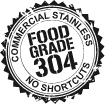
304 Versus 430 Stainless Steel
What a steel – 304 or 430?
Are you in the market to set up or upgrade a café or restaurant kitchen? There are so many elements to consider and throw in huge price variations for what looks like the same product, you might be rocking in a corner wondering what you got yourself into. When it comes to stainless steel products, it’s important to be aware of the difference in quality when you’re faced with cheap price tags.
For those of us with untrained eyes to the specificities of metals, you might have thought stainless steel was all one and the same. However, there are a variety of stainless-steel grades on the market depending on the desired usage, which mainly include 304 (for commercial kitchens) and 430 (lower grade for domestic kitchens and mechanical purposes).
At Brayco, we highly recommend that our customers investing in quality kitchen equipment (particularly commercial kitchens), choose 304 stainless steel over 430 because of the key difference – non-porous versus porous properties. Some of our competitors (don’t ask us to name names, we’re classy) are producing cheaper stainless-steel products due to the similarity in look, feel and touch of the two alloys. Here’s what you need to know when choosing your equipment.
 What are the key differences between 304 and 430?
What are the key differences between 304 and 430?
304 stainless steel is made up of around 18% chromium and 8% nickel. This combination creates excellent corrosion resistance from most oxidising acids, it’s highly durable and easy to sanitise (just soap and water will do it). The key attribute of 304 is it’s non-porous or impervious (councils love this word, fair warning), which makes it safe to prepare food on as it doesn’t absorb grease, food particles or water.
430 is a plain chromium ferritic stainless steel with no nickel content which makes it a cheaper option, but it’s also less resistant to corrosion, less durable and porous in nature. 430 is fine for residential sheds, arts and crafts, and some home kitchen appliances (such as knives) but for commercial kitchen use, we recommend paying more for the 304 options.
This non-porous nature of 304 versus 430’s porous surface is critical in a kitchen environment where you want the most hygienic surface possible to prevent food bacteria. Call us crazy, but the last thing you want for your business is to be the source of salmonella or other nasty foodborne bacteria. A side of food poisoning with your carefully prepared special of the night? It’s a risk we wouldn’t be willing to take, that’s for sure.
 How can I tell which grade steel is used in a product?
How can I tell which grade steel is used in a product?
Spend three years at university and score yourself a metallurgy degree. Don’t have that much time? Neither do we. Visually, it’s hard to tell the difference but there are some quicker ways than adding ‘metallurgist’ to your vast list of qualifications.
For those of you who carry a magnet in your back pocket, whip it out and check it against the surface of the stainless steel. If it drops to the ground, you’ve got yourself a high quality 304 stainless steel. If it clings to the table, say hello to a lesser grade 430.
Another option is to be brazen – ask the seller outright what grade they’re using. Many companies don’t disclose the grade of stainless steel upfront (particularly if it’s 430), so be savvy and ask. They might use the word ‘ferritic’ which simply means iron-based, aka 430, which you know because you’re a clever cookie who did your research.
But I really like cheap things… can I use 430 in my commercial kitchen?
We hear you, finding a bargain is a great victory. Once upon a time, food regulations stipulated all commercial operations must have non-porous surfaces for food preparation. Food Standards Australia maintains the guideline of an ‘impervious’ surface in its criteria. Local council’s standards now vary so you must confirm which grade is required before purchasing. It’s worth remembering, regardless of your council’s requirements, that it’s a lot more costly to have a hygiene incident and lose customers than to set your kitchen up with the highest standard stainless steel surfaces right from the start.
What does Brayco do?
It’s a philosophical question for the ages, alright… but sharpening our focus to stainless steel, we are currently 100% 304 stainless steel in all of our benches, cabinets, shelving and sinks. Bring your fridge magnet and test us at one of our stores across Australian and New Zealand.




